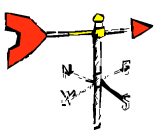
Prevailing Winds
 The direction of wind is measured in terms of where the air is coming from. A northerly wind blows air from north to south. A southwesterly wind blows air from the southwest to the northeast.
The direction of wind is measured in terms of where the air is coming from. A northerly wind blows air from north to south. A southwesterly wind blows air from the southwest to the northeast.
The prevailing wind is the wind that blows most frequently across a particularly region. Different regions on Earth have different prevailing wind directions which are dependent upon the nature of the general circulation of the atmosphere and the latitudinal wind zones.
In general, the following prevailing winds across the Earth may be identified, although variations arise due to the positions and differential heating rates of the continents and oceans.
|
Latitude |
Direction |
Common Name |
|
90-60°N |
NE |
Polar Easterlies |
|
60-30°N |
SW |
Southwest Antitrades |
|
30-0°N |
NE |
Northeast Trades |
|
0-30°S |
SE |
Southeast Trades |
|
30-60°S |
NW |
Roaring Forties |
|
90-60°S |
SE |
Polar Easterlies |
Wind generally blows from high pressure to low pressure, but does not take the most direct north-south route between the pressure belts on account of the Earth's rotation, which deflects airflow by means of the Coriolis force.
The British Isles lie at the convergence zone between the warm southwest antitrades and the cold polar easterlies. Convergence of warm and cold air masses at this latitude produces cyclonic low pressure and the development of rain-bearing depressions, whish sweep across the Atlantic to influence the British climate. The prevailing winds are the mild southwesterlies, but for much of the time, the British Isles are influenced by polar air masses with a northwesterly or northerly airflow, that bring with them colder showery weather.
Prevailing winds in the Indian Oceans are northeasterly. During the summer months however, a larger low-pressure system develops over southern Asia due to continental heating. Winds in this region now reverse to form the Southwest Monsoons, which bring a prolonged wet season to Southeast Asia and the subcontinent of India.
Websites
Other topics
Trade Winds
WINDPOWER.dk
Prevailing Winds
World Winds
C@wley.Net
Introduction
Air Masses
Average Weather
British Climate
Climate Change
Climate Zones
Climatology
Continental Climate
Desert Climate
El Niño
General Circulation
Global Climate
Gulf Stream
Ice Sheets
Land & Sea
Latitude
Local Climates
Maritime Climate
Measuring Climate
Mediterranean Climate
Monsoons
Mountains
Oceans
Polar Climate
Pressure Patterns
Prevailing Winds
Rainfall Patterns
Regional Climates
Savannah
Seasons
Temperate Climate
Temperature Patterns
Tropical Climate
Wind Belts
 Print Topic
Print Topic